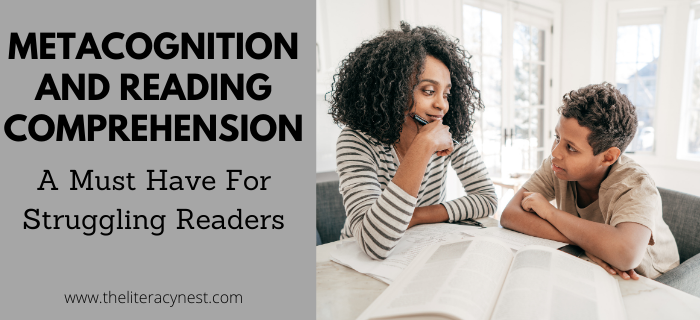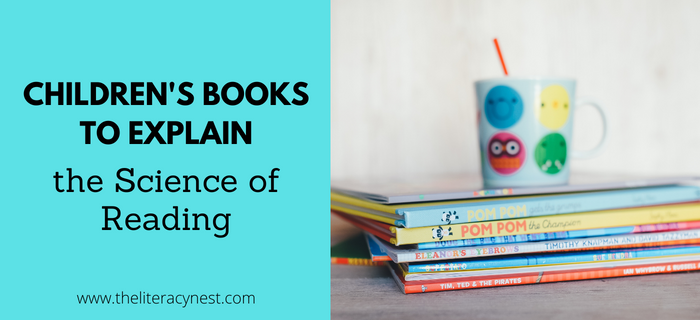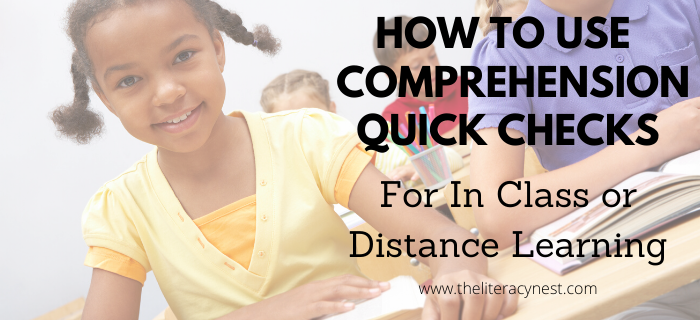Metacognition and Comprehension Strategies : Critical for Struggling Readers

As teachers and tutors, you know that we must go beyond helping our students learn to decode and read fluently. Comprehension is the end goal for all of the instruction and practice that we provide. BUT how do you know WHAT and HOW to teach in order to help our students improve in this critical component of reading?
Reading skills such as making inferences, determining main idea, identifying cause/effect are important. However, they are isolated skills that do not turn our struggling students into thoughtful readers. To do this, we must focus on reading strategies, specifically those that promote metacognition.
Enjoy this guest post written by Lynn Givens, author of Connect to Comprehension!
What is metacognition?
Simply put, it is thinking about one’s own thinking. This involves the reader’s awareness of the status of his own thinking while reading and the executive control he has over his own thinking. Proficient readers continually monitor their own thoughts while they are reading. They know WHEN they don’t understand and WHAT they don’t understand, and they have a TOOL BAG of fix-up strategies. They ask themselves questions while they are reading to confirm their understanding. They think ahead and predict, and they often form mental images as they connect with the text.
How can we promote this kind of thinking with our dyslexic students, who may still be struggling to decode?
- Model metacognitive processes while reading aloud to students. Preview the text before reading aloud; make connections to personal experiences and other texts; ask questions to clear up misunderstandings. Let your students see and hear you doing this, so that they can begin to understand the type of thinking they must do.
- Use decodable texts or texts that students can read easily. This will free up their “cognitive space” to help them focus on the strategies that they will be learning and practicing.
- Teach the essential comprehension strategies and provide opportunities for scaffolded practice with your students.
Here are the most powerful of these strategies.
– Self-monitoring Students who are good at monitoring their comprehension know when they understand what they read and when they do not. They have strategies to “fix” problems in their understanding as the problems arise. Research shows that explicit instruction, even in the early grades, can help students become better at monitoring their comprehension.
Comprehension monitoring instruction teaches students to:
- Be aware that they do understand
- Identify what they do not understand
- Look back through the text to clear up misunderstandings
– Summarizing requires students to determine what is important in what they are reading and to put it into their own words. Instruction in summarizing helps students:
- Identify or generate main ideas
- Focus on key details, since all details cannot be included in a summary
- Connect the main or central ideas
- Use key words and phrases – This is part of determining the important parts of the passage
- Eliminate unnecessary information
– Graphic organizers are known by different names, such as maps, webs, graphs, charts, frames, or clusters. Regardless of the label, graphic organizers can help readers focus on concepts and how they are related to other concepts. Graphic organizers can help students read and understand all types of texts by providing a visual model for organizing their thoughts and ideas. These visual models are critical for our dyslexic readers.
– Generating questions keeps readers focused. By asking themselves questions as they read, students become aware of whether they can answer the questions and if they understand what they are reading. Students learn to ask themselves questions that require them to combine information from different segments of text.
– Relating text material to prior knowledge helps us make sense of what we are reading. When reading, we automatically use our personal experiences and what we have previously learned to make written text more personal and meaningful. Students with dyslexia or other struggling readers may have a problem connecting prior knowledge to written information. They may be lacking in this knowledge due to their overall lack of reading. We can help our students activate prior knowledge by pre-teaching vocabulary, providing background knowledge and creating opportunities to continue building background knowledge.
– Generating mental images has been shown to be an effective strategy for comprehending text. For many readers, visualizing is automatic; for them, reading generates a streaming video of images running through their minds. Many struggling readers do not use this strategy at all. When asked to tell what they can “see” from what they have read, they frequently report, “I don’t know.” Teaching our students to “draw mind pictures” or to “make mind movies” can be a powerful strategy for increasing their comprehension while they are reading.
To learn more about how to teach and practice eight essential comprehension strategies, sign up and participate in the course in the Connect to Comprehension Center for Literacy Learning
https://connect-to-comprehension-center-for-literacy-learning.teachable.com/p/comprehension

To read more about the impact of metacognitive strategies on reading comprehension and about a research study that reflects this impact, view the following link: https://www.readingrockets.org/article/instruction-metacognitive-strategies-enhances-reading-comprehension-and-vocabulary

Lynn is offering 10% off the Connect To Comprehension Kit shown below until 2/28/21!
Enter the code LN2021 when you checkout on this PayPal page.
Thank you for stopping by!







